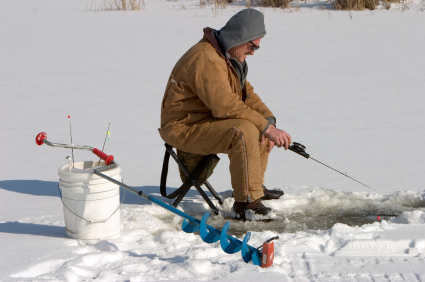
 With ice fishing, snowmobiling and cold-weather hunting just around the corner, one of the most important survival skills to know is what you should do if you fall through thin ice.
With ice fishing, snowmobiling and cold-weather hunting just around the corner, one of the most important survival skills to know is what you should do if you fall through thin ice.
If you’re one of the two million fisherman who ice fishes each year, or you’re a snowmobiler or a cold-weather hunter, here are the steps you should follow in the unfortunate case that you accidentally fall through the ice:
- As soon as you’ve fallen through the ice, get to the surface as quickly as possible and then focus on your breathing. After a plunge into ice-cold water, the body experiences a “cold shock” sensation that can result in hyperventilation and gasping; do your best to keep these reactions under control to conserve as much energy and agility as possible.
- Shed any heavy items weighing you down, such as a backpack.
- Move toward the ice in the direction from where you fell. This ice is likely to be the most sturdy there.
- Alert a companion that you’re in trouble.
- Use your best option to help you get out. If possible, use an ice pick, knife or another sharp object to stick into the ice and help you pull yourself out. Alternatively, have your companion throw you a length of rope from a long distance away in order to assist you. Though using an ice pick or some other substitute to stick into the ice is probably your best bet, you don’t always have such a tool available. If you find yourself in this situation, “Don't try and pull yourself out of the water like you're pulling yourself out of a swimming pool,” says Dr. Howard Donner, co-author of “The Field Guide of Wilderness Medicine,” in an interview with outsideonline.com. He continues, “Simultaneously kick and pull your way out horizontally—like a seal getting out of the water onto ice.” (If you absolutely cannot get out, get as much of your body out of the water as possible, stop struggling and wait to get rescued.)
- Once you’ve pulled yourself onto the ice, avoid standing up. Instead, keep your weight more evenly distributed over the ice -- and avoid breaking it further -- by remaining horizontal and rolling toward safety. Once you’re a good distance away from the opening in the ice, crawl until you get to shore.
- Warming up is essential. Place fire starters or waterproof matches in a sealed plastic bag in a zipped pocked of your jacket. Starting a fire if no other source of warmth is available may be your only option until help arrives.
- Seek medical attention immediately, even if you don’t think you need it.
As always, use proper ice safety practices -- including knowing when ice is safe, wearing a life jacket, carrying ice picks and always bringing along a partner -- when on or near the ice. Remember this rhyme when examining the ice you’re about to walk on: “Thick and blue, tried and true; Thin and crispy, way to risky.” Read more about ice safety.
Enjoy your outdoor adventures, and be safe!
- 5526 views

